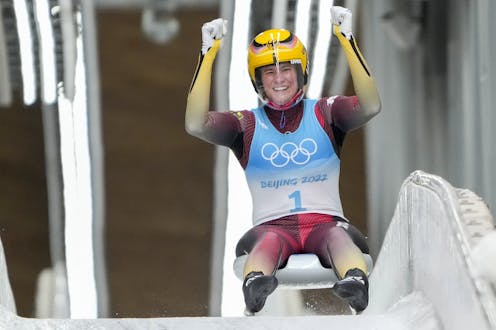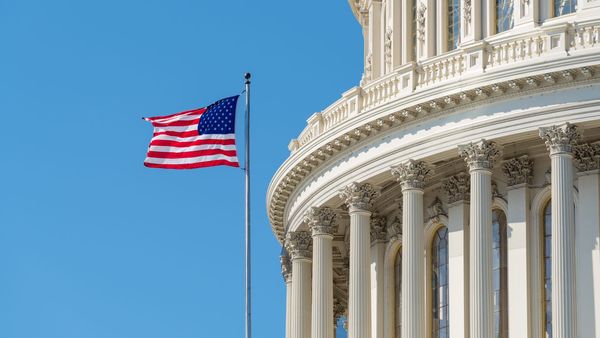
Every two years the world watches in awe as incredible athletes compete during the Olympic and Paralympic games. Olympians inspire the nation, and serve as role models to all young athletes. But after inspiring so many, and as the Olympics close, athletes are faced with a new question. What’s next?
Elite sport requires a level of commitment that often means sacrificing other aspects of life. In many sports, the window of peak performance and the window of fertility for female athletes overlap in their twenties and thirties. Female athletes who desire to have a family are often faced with a difficult choice.
They can continue to train and build their athletic career, retire from their sport to become mothers, or they can attempt to do both with few supports and many roadblocks.
Growing number of Olympian mothers
The 2022 Beijing Games celebrated a growing number of Olympian mothers. Bobsledder Elana Meyers Taylor (United States), biathlete Anaïs Chevalier-Bouchet (France) and luger Natalie Geisenberger (Germany) all medalled in their respective sports.
These “super moms” seemingly can do it all. But behind these successes are the struggles, challenges and heartbreaking decisions that elite athlete mothers are forced to make.
In the lead up to the 2020 Tokyo Games, Canadian Basketball player Kim Gaucher was initially faced with the decision to leave her three-month-old breastfed baby at home or miss the Olympics. Eleven-time Canadian champion boxer Mandy Bujold was deemed ineligible to compete at the Tokyo Olympics because of missing qualifiers due to her pregnancy.
Although rules were eventually changed to allow both to compete, these examples highlight the urgent need to update sport policy to reflect the fact that pregnancy and parenthood no longer mean the end of an athletic career.
In 2019 American sprinter Allyson Felix wrote about her fight to get maternity benefits from her sponsor, Nike, in the New York Times. She was one of the most decorated, high-profile athletes in the world, and she struggled to find support during her pregnancy. And she is not alone.
Experiences of elite female athletes
Our team recently conducted a study to detail the experiences of elite female athletes as they navigate pregnancy, and to identify sport policy considerations regarding pregnancy.
We recruited 20 athletes (including 10 Olympians) who had trained or competed at the elite level immediately prior to becoming pregnant. Stories shared by participants highlighted the many significant decisions athletes must make.
They described the complexities related to planning for pregnancy when training. They told us heartbreaking stories about how they were scared to disclose that they were pregnant over fear they would lose their position on the team, lose funding or even be viewed as less committed to their sport. This needs to change.
One athlete we spoke with said, “During an Olympic cycle, you want to get pregnant in the first year of the cycle before your quadrennial … like you have a very narrow window to try and succeed or wait another four years.”
Another athlete added, “I feel like I can’t have open communication [with coaches] because I’m so afraid of what will be taken from me.”
“Best practice” policies for pregnant and postpartum athletes have been produced by professional sport organizations including the Women’s National Basketball Association, and the Ladies Professional Golf Association (LPGA).
The LPGA developed a policy that was “pro-athlete and pro-mom” to reflect the changing demographic of high-profile LPGA players becoming elite athlete mothers. Few sport organizations in Canada have policies that are specific to pregnancy; typically, pregnancy is classified as an “injury.” This lack of policy, or classification of pregnancy as injury, is clearly problematic and has negative consequences for female athletes.
Developing policies and funding
Our research with trailblazing pregnant elite-level athletes provides clear recommendations that would create sport environments that support and value pregnancy in elite athletes. And these reccomendations can be implemented immediately.
For example, the development of maternity leave policies and funding structures for parental leave should be a priority for sporting organizations. Providing education to athletes, coaches and organizations about reproductive health should also occur in an effort to normalize pregnancy in sport, and work towards a more inclusive environment for female athletes.
In Budget 2018, Canada set a target to “achieve gender equity in sport at every level by 2035.” Without policies in place to support pregnant and postpartum athletes, women are being excluded at some of the highest levels of sport participation in Canada.
Policies to support pregnant athletes will have a direct impact on all women and girls across all levels of sport. Role models are essential to girls’ continued participation in sport. Young girls need to know that they belong in sport, and that there is a space for them in sport even when they enter their reproductive years.
Sport policy and practices to support pregnant athletes directly impacts athletes across all levels of sport. As the 2022 Beijing Olympics and Paralympics close, we have an opportunity to change the future for athletes, so they can continue to inspire Canadians for years to come.
Margie Davenport receives funding from the Christenson Professorship in Active Healthy Living, NSERC, SSHRC, Heart and Stroke Foundation of Canada, the Women and Children's Health Research Institute, and Canada Foundation for Innovation. She received a stipend from the Canadian Society for Exercise Physiology to develop the Pre & Postnatal Exercise Specialization.
Tara-Leigh McHugh receives research grant funding from the Social Sciences and Humanities Research Council (SSHRC).
This article was originally published on The Conversation. Read the original article.







